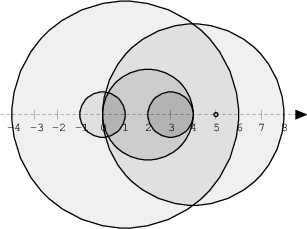Task discription
We draw N discs on a plane. The discs are numbered from 0 to N − 1. An array A of N non-negative integers, specifying the radiuses of the discs, is given. The J-th disc is drawn with its center at (J, 0) and radius A[J].
We say that the J-th disc and K-th disc intersect if J ≠ K and the J-th and K-th discs have at least one common point (assuming that the discs contain their borders).
The figure below shows discs drawn for N = 6 and A as follows:
A[0] = 1
A[1] = 5
A[2] = 2
A[3] = 1
A[4] = 4
A[5] = 0 There are eleven (unordered) pairs of discs that intersect, namely:
There are eleven (unordered) pairs of discs that intersect, namely:
- discs 1 and 4 intersect, and both intersect with all the other discs;
- disc 2 also intersects with discs 0 and 3.
Write a function:
int solution(vector<int> &A);that, given an array A describing N discs as explained above, returns the number of (unordered) pairs of intersecting discs. The function should return −1 if the number of intersecting pairs exceeds 10,000,000.
Given array A shown above, the function should return 11, as explained above.
Write an efficient algorithm for the following assumptions:
- N is an integer within the range [0..100,000];
- each element of array A is an integer within the range [0..2,147,483,647].
Source code
#include <algorithm>
int solution(vector<int> &A) {
vector<long long> lower, upper;
int n = A.size();
// 각 디스크의 시작, 끝 구하기
for(int i=0;i<n;i++) {
lower.push_back((long long) i-A[i]);
upper.push_back((long long) i+A[i]);
}
sort(lower.begin(), lower.end());
int cnt = 0;
for(int i=0;i<n-1;i++) {
for(int j=i+1;j<n;j++) {
if(cnt > 10000000)
return -1;
// 디스크가 아예 교차하지 않으면 break
if(lower[j] > upper[i])
break;
// lower 기준 디스크 교차 여부 체크
if(lower[j] >= lower[i] && lower[j] <= upper[i])
cnt++;
}
}
return cnt;
}
Review
- lower와 upper를 기준으로 문제를 해결하려 했더니 시간초과 에러가 발생했다.
lower를 정렬한 후 디스크 교차 여부를 체크하는 방식으로 변경해야 시간복잡도가 O(N*log(N)) or O(N)가 되어 통과할 수 있다. - overflow 에러가 발생해 lower과 upper를 long long 타입으로 처리해주어야 했다.
